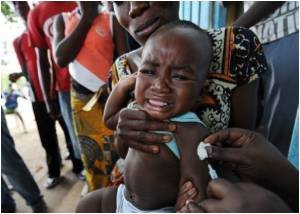New malaria tool shows which kids at greatest risk
Researchers at Michigan State University have identified a test that can determine which children with malaria are likely to develop cerebral malaria, a much more life-threatening form of the disease.
The screening tool could be a game-changer in resource-limited rural health clinics where workers see hundreds of children with malaria each day and must decide which patients can be sent home with oral drugs and which need to be taken to hospitals for more comprehensive care.
“Rural health workers have to make these decisions with very little objective data, and the consequences of an inappropriate decision are huge,” said Karl Seydel, MSU assistant professor of osteopathic medical specialties. “Children who progress to cerebral malaria have a 20 percent mortality rate, or even higher if they don’t get the right treatment early in the disease process.”
In a new study in the Journal of Infectious Diseases, Seydel and colleagues report that testing patients’ blood for HRP2 – a protein produced by the malaria parasite – was an accurate predictor of how the disease progressed among children at Queen Elizabeth Central Hospital in Blantyre, Malawi.
“We found that if HRP2 levels are low, clinicians can be more than 98 percent sure the child will not progress to cerebral malaria,” Seydel said. “That would give them the confidence to merely prescribe oral drugs and send the child home.”
Nowhere is the need for such a tool greater than in Africa, where 90 percent of childhood malaria deaths occur. Only about 1 percent of children with malaria develop the life-threatening form of the disease, yet an estimated one million African children die from it each year.
What are the symptoms of malaria?
Your baby is unlikely to get malaria in the first two months of her life. This is because of the immunity you gave her during your pregnancy. As she grows older, she loses that immunity, and her risk of catching malaria increases.

Malaria tends to be more severe in children under five years old. Symptoms start showing about 10 days to four weeks after being bitten.
If your little one is younger than five, you should look out for these symptoms:
fever
shivering
cold
irritability and drowsiness
poor appetite
sleeplessness
vomiting
stomach pain
hypothermia (instead of a fever)
rapid breathing
If your child is older than five, she will have the same symptoms as adults do. They are similar to flu-like symptoms and include:
a high fever, sometimes in 48-hour cycles of shivering and then extreme sweating
headaches
chills
nausea and vomiting
body aches
loss of appetite
“In most of Africa, where resources are still so limited, using those available resources appropriately and intelligently is of great importance,” Seydel said.

The HRP2 test in its current form is costly and poorly suited to use in rural clinics, Seydel noted. He and colleagues are in the process of developing a less expensive, more portable version.
Seydel’s collaborators on the study include MSU researchers Lindsay Fox, Terrie Taylor and Mathew Reeves, along with partners from the University of Malawi College of Medicine.
Malaria is alive and well and killing more than 3000 African children every day
An estimated 20 per cent of the world’s population - mostly those living in the world’s poorest countries - is at risk of contracting malaria. Malaria causes more than three hundred million acute illnesses and kills at least one million people every year. Ninety per cent of deaths due to malaria occur in Africa, south of the Sahara, and most deaths occur in children under the age of five.
“Malaria kills an African child every 30 seconds, and remains one of the most important threats to the health of pregnant women and their newborns,” said Carol Bellamy, Executive Director of UNICEF. “We have the knowledge and the potential to achieve our target of reducing the global burden of malaria by half by 2010, but we need much greater investment and political commitment.”
The Africa Malaria Report challenges the global community to step up the momentum by:
Increasing global investment to support implementation of programmes to control malaria in endemic countries;
According higher priority to malaria on the health agenda of endemic countries;
Encouraging greater private sector involvement in the national supply and distribution of quality antimalarial drugs, and insecticide treated nets;
Ensuring the availability of the new generation of highly effective antimalarial combination drug treatments to populations at risk;
The Africa Malaria Report acknowledges the contribution of global efforts to the substantial progress already made by a number of countries that have adopted cost effective strategies to fight the disease with greater focus on the most vulnerable - women and young children.
The National Institutes of Health supported the research.
###
Contact(s): Andy McGlashen , Karl Seydel